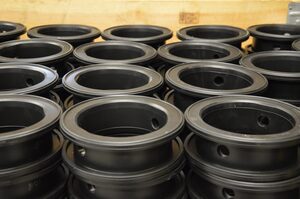Types of rubber
Body
Simply you can say that there are two types of rubber. Natural rubber and synthetic rubber. Synthetic means that it is made by man. In a factory. Natural rubber is the oldest and synthetic rubber was actually invented and developed because we wanted to imitate rubber. On the one hand because there was too little natural rubber, on the other hand to make a rubber with different desired properties.
Study natural rubber
If you look closely at the sap from the bark of the rubber tree, you will see small white flakes. That's the actual rubber. If you “look” at the molecules in it, you see that they are long molecules, more chains. If you don't put any force on it, you don't pull on the rubber, it's a jumble of long molecules stuck together or twisted around each other here and there. If you pull on rubber, the molecules will line up next to each other.
Challenge for researchers
How are those chains or polymers built up? Could those chains be made up of even smaller particles? That is a question that scientists began to investigate. Because the idea was: if we know how rubber molecules are built up, we might be able to imitate them. And indeed, the researchers discovered those smaller particles of natural rubber and called them monomers. And it turned out that they could make polymers from those monomers in the lab. And they got the natural rubber back. Natural rubber but man-made. Only making that rubber from the lab or from the factory was very expensive.
Synthetic rubber
Can you make cheaper rubber? To this end, researchers started working with other cheaper monomers. For example, they discovered various synthetic rubbers, made from raw materials that come from petroleum. A very well-known synthetic rubber is styrene-butadiene rubber. And you already know that we often use abbreviations. That is why we call this synthetic rubber SBR. This rubber is still widely used in car tires.
Differences
Exactly what people hoped happened. Not only did they succeed in imitating natural rubber, but they even succeeded in making better rubber. An example of this is that natural rubber ages after some time. You probably know that from a rubber band that dries up. It becomes hard and crumbly and it falls apart. Many synthetic rubbers that we make today do not have that at all. They are resistant to wind and weather, to heat and cold, to sunlight and drought. Researchers are therefore able to make synthetic rubbers with properties that we need. Nowadays, both natural rubber and synthetic rubber are used side by side depending on what is needed.
More synthetic rubber
We still use a lot of natural rubber, but the various artificial rubbers have been “winning” for years. More than half of all the rubber we use is artificial rubber.
Microwave Rubber Vulcanization Suppliers in Kuwait
Microwave Preheater for Rubber Tyre Suppliers in Malaysia








Comments